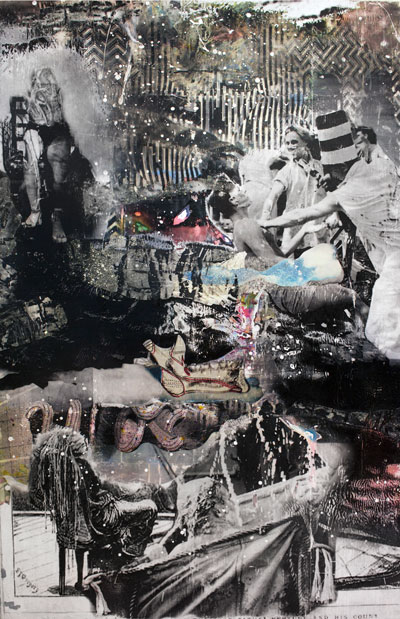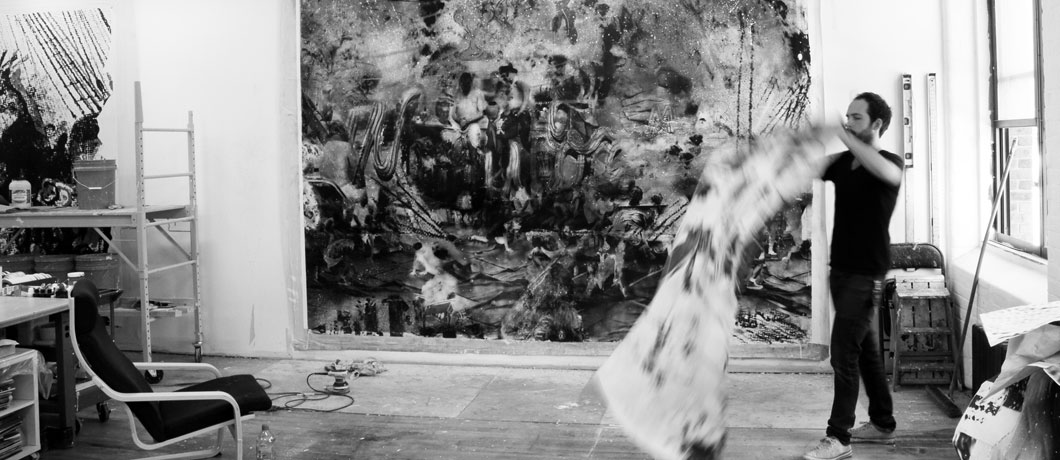Anthony Keith Giannini Sifts Through Images to Accumulate Meanings
Providence, R.I.-based artist Anthony Keith Giannini earned a master’s degree in painting from the Rhode Island School of Design in 2012 and was included in the Fort Worth Drawing Center’s Contemporary Drawing Today earlier this year. His first Dallas solo exhibition, Crossing the Line, appears Sept. 4-Oct. 18 at Oliver Francis Gallery. He talked with fellow artist Arthur Peña about his process.
PHOTO ABOVE: Giannini in his studio. Courtesy of the artist.

Said Neptune Rex, “the displeasure is all mine. Your ship is infested with nefarious and slimy Polywogs, a situation which my Royal Party intends to correct by making the fit Shellback for my raging main” (Mar), 2013.
Oil, acrylic and toner transfers on canvas.
Courtesy of the artist.
A+C Texas: These works are packed full of imagery that provides a swirling mass of information. But before we get to that I want to discuss how these paintings are built. On a formal level, they all seem to have a center image that radiates imagery and text.
Anthony Keith Giannini: The centralized figure is definitely a byproduct of process. The initial layers never start off with a central figure. The work is materialized through the accumulation of individual toner transfers, manipulated with paint, some abstract and some representational, that end up creating a collage-like aesthetic throughout each piece.
The reappearing central figure is about the passage through the colossal to arrive at the intimate. It is an entry point, as well as a pit-stop for the viewer. I am constantly constructing and eroding, throughout all stages of the painting, until I get to the point where I have the canvas largely at play. That is to say, the work finds completion when the different figures, their gestures and grins, are in some sort of achieved tension. Artists such as Théodore Géricault, Francisco Goya, and Leon Golub have created this type of fervent tension that I’m interested in.
A+C: The artists you mention all have a “political” body of work. More directly and less abstractly, they all deal with a very real understanding of power structures. Is this your interest as well?
AKG: It is. Part of my source material is collected from events that demonstrate the various forms and effects of power structures: constraint and enablement, military might, social influence, persuasion, compliance, and the use of interrogation to control dissidence or opposition.
These forms all trickle down and affect our public and private behavioral gestures; images that make up the second half of my source material. The combination of these two is something that I’m paying close attention to when looking at images recorded in times of conflict: the body exposed to physical and psychological trauma.
A+C: Do you mean that art painting has the potential to offer transcendence? The imagery in your work is so rooted in violence, can it take us somewhere beyond the surface-laden chaos?
AKG: Painting should point to something beyond itself and the one who made it. A lot of it has to do with what the artist and viewer are willing to bring to the table. Process and a slow read have a lot to do with that. I’m thinking about Polke’s alchemistic processes or how Rothko, Pollock and de Kooning used the process of painting as event and the canvas as its reflection.

The initiate being dunked by the ‘bears’ after being shaved by Neptune Rex’s barber (Dunk), 2013.
Oil, acrylic and toner transfers on canvas.
Courtesy of the artist.
Process becomes an extension of painting that influences the way I’m sifting through images. Because of the complications of power structures, the work mimics exactly that. There is density, there is chaos, and there are very few moments of rest. This might mean that there are times in the work where the viewer cannot get passed the surface laden chaos. And maybe the paintings become containers to understand and confront these complications.
A+C: The images in the work do carry a lot of weight. Where are you pulling them from and what are your criteria for choosing the images?
AKG: There are three main sources I drew from for this body of work. I pulled from several photo blogs created by veterans to commemorate the Line-Crossing Ceremony, as well as the Marine Photo Service collection, which contains 16,000 negatives from the 1920s to the 1970s. The third source is an engraving entitled Crossing the Line by T. Landseer that depicts the first time Charles Darwin crossed the equator and performed the Line-Crossing Ceremony while aboard the HMS Beagle.
I ask a lot from the material I collect. I want something mundane, exciting, tragic, heroic, and something contradictory to work through. There has to be a bizarre associative quality between at least three different images before I even begin to appropriate and dismantle the imagery. Someone is being dunked, someone is being water-boarded, and Marc Summers is sliming the red team on television. To balance the seriousness of the imagery, there has to be some absurdity involved.
Also, spending time with the work once it’s finished is important for me. It’s a way to link blatant and obscure passages being made in the work.
—ARTHUR PEÑA
Anthony Keith Giannini: Crossing the Line
Oliver Francis Gallery
Sept. 4-Oct. 18
![]()

